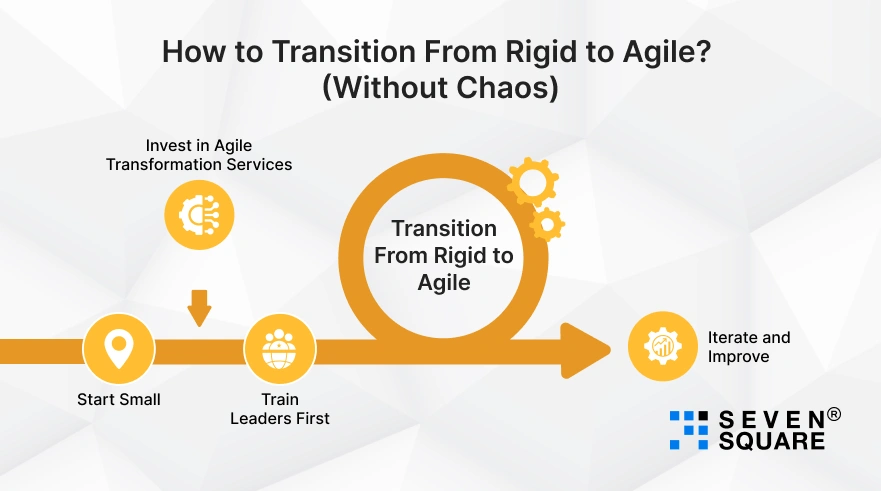We’ve seen it many times: Teams don’t miss deadlines because they lack talent; they miss them because they’re rigid.
A rigid development team follows processes so tightly that even a small change feels like a roadblock.
On the other hand, an agile development team sees change as an opportunity to improve delivery.
The truth? Small issues rarely arrive with warning bells. They whisper.
A few hours of bottlenecks today, a slight delay in approvals tomorrow, and suddenly, a project that should have shipped on time is weeks behind.
From our perspective, the real difference between agile vs rigid teams is simple:
- Rigid teams react when problems explode.
- Agile teams adapt before problems escalate.
We believe flexibility is not just about moving faster; it’s about building teams that can spot the whispers before they turn into screams.
Here in this blog, you can learn about agility vs rigidity and why having an agile development team can be beneficial for your business.
Agility vs. Rigidity: What’s the Difference (and Why It Matters?)
So, what exactly is agility vs rigidity in a team context?
- Agility means your team can adjust quickly to changes, whether it’s shifting client priorities, new market conditions, or unexpected technical problems.
- Rigidity means your team sticks to one fixed plan, even when the situation demands flexibility.
Here’s a simple comparison:
| Agile Development Team | Rigid Development Team |
|---|---|
| Adapts quickly to new requirements | Struggles when scope changes |
| Encourages collaboration & feedback | Operates in silos with little feedback |
| Improves continuously with iteration | Waits until the end to deliver results |
| Higher client satisfaction | Frustrated clients due to delays |
| Delivers value faster | Risks project failure under pressure |
This is why agile development services have become important for modern businesses.
An agile development team not only delivers projects on time but also ensures that clients stay engaged, satisfied, and confident throughout the journey.
Explore the Comparison of Agile vs Waterfall Methodology.
What is the Cost of Rigidity? (Hidden Losses You Don’t See Until It’s Too Late)
On the surface, a rigid development team may look efficient: processes are followed, deadlines are set, and everything seems “under control.”
But underneath, problems quietly pile up. Here’s what we’ve seen:
- Missed Deadlines: Rigid teams often can’t adapt when requirements shift.
- Wasted Resources: Hours spent fixing problems that could’ve been prevented.
- Unhappy Clients: Frustration grows when flexibility is missing.
We once worked with a client who noticed their system slowed down by just 4 seconds. To most, this seemed minor.
But if the team had stayed rigid, those 4 seconds would’ve snowballed into missed deliveries, customer complaints, and competitive losses.
Instead, by applying agile development services, we helped turn that delay into a competitive advantage.
The system not only recovered but became faster, more scalable, and more reliable, all because the team embraced agility.
The lesson? Rigid development team problems are like whispers. And by the time they get loud, it’s already too late.
Why Flexible Teams Always Win? (Proven Competitive Advantages)

We’ve seen this play out again and again: Rigid teams struggle, while agile teams outpace competitors.
The reason is simple: A flexible team adapts when things change. A rigid development team breaks under pressure.
That’s why organizations are turning to agile development services to stay ahead. Here’s why flexible teams always win:
- Speed: Agile teams deliver faster because they work in smaller cycles, making quick improvements instead of waiting months.
- Collaboration: Clients stay engaged at every step, reducing misunderstandings and surprises.
- Adaptability: Market shifted? Priorities changed? Agile teams adjust without missing a point.
- Client Satisfaction: Instead of rigid processes, clients get results according to their needs, on time, and with confidence.
We’ve seen companies lose opportunities because they held onto rigidity.
Meanwhile, clients who adopted agile development services achieved scalability, reduced risks, and turned challenges into growth.
Inside an Agile Development Team: What Makes Them Different?
So, what really makes an agile development team stand apart from a rigid one?
We don’t just train teams to “work faster.” We build flexible teams that can handle pressure, shifting demands, and last-minute changes.
Here’s how:
- Cross-functional roles: Developers, testers, and designers work together, not in silos.
- Daily collaboration: Quick syncs keep everyone aligned and reduce delays.
- Iterative delivery: Instead of waiting months, clients see progress every week.
- Flexible team training: We ensure teams don’t just adopt agile tools, but agile mindsets.
One example: A client came to us with urgent last-minute changes.
- Their old, rigid development team froze, delays piled up, & frustration grew.
- Our agile development team, however, reorganized tasks, adapted the plan, and delivered the new requirements in just days.
That’s the difference: Agility turns problems into opportunities, while rigidity magnifies them.
How to Transition From Rigid to Agile? (Without Chaos)

Many leaders ask us: “How do we move from a rigid structure to an agile one without losing control?”
The answer is, step by step. We help companies transition from rigid to agile using proven methods.
Here’s how to do it:
- Start Small: Run a pilot project with an agile development team before rolling it out company-wide.
- Invest in Agile Transformation Services: Don’t just change tools; transform workflows and culture.
- Train Leaders First: An agile team succeeds only when managers and leaders adopt flexibility.
- Iterate and Improve: Use feedback loops to adapt continuously instead of one big risky change.
Whether you’re exploring how to transition a rigid team to agile or seeking expert agile consulting services, the key is to focus on adaptability, not perfection.
We’ve helped startups and enterprises alike through this change & the results speak for themselves: faster deliveries, happier clients, and teams that grow under change.
What’s Our Approach to Turn Rigidity into Agility?
Over the years, we’ve helped clients who were stuck with rigid development teams to reach their true potential through agile development services.
A client once came to us saying, “We need more developers to speed things up.”
But what they really needed was more flexibility.
Once we restructured their workflow into an agile development team, deadlines were met, client satisfaction increased, and projects scaled without chaos.
Here’s how our agile development services make it happen:
- Faster Project Turnaround: Agile cycles ensure quick wins and visible progress.
- Predictable Delivery: Clients always know what’s coming next.
- Scalable Team Models: Teams expand or contract seamlessly as requirements evolve.
- Client-First Adaptability: Changes are welcomed, not feared, so clients feel in control.
We don’t just fix rigid processes; we replace rigidity with agility that creates lasting impact.
Want an Agile Development Team? Contact Us Today!
Agile vs Rigid: A Quick Reality Check
When it comes to agile vs rigid, the gap isn’t just about methodology; it’s about results.
Here’s what we’ve seen across projects:
| Factor | Agile Development Team | Rigid Development Team |
|---|---|---|
| Delivery Speed | Faster releases in small & manageable cycles. | Long waits & big delays if scope changes. |
| Cost Efficiency | Controlled spending with iterative improvements. | Higher costs due to rework and missed deadlines. |
| Scalability | Teams can grow or shrink flexibly. | Scaling requires heavy restructuring. |
| Innovation | Encourages creativity & client feedback. | Stifled by rigid processes. |
| Client Satisfaction | High as clients see progress early and often. | Low as clients wait too long and feel left out |
The winner is clear: Agile development services consistently outperform rigid approaches, helping companies deliver faster, adapt better, and grow stronger.
Flexibility Is Survival
We’ve seen the same truth across industries: Rigid teams break under pressure. Flexible teams adapt, grow, and win.
So the choice is clear. You can stay rigid and risk falling behind or adopt agility and lead the competition.
FAQs
- If your team struggles with last-minute changes, misses deadlines often, or avoids client feedback, chances are you have a rigid development team.
- The cost depends on project size and complexity, but we provide agile development services that are cost-effective and ROI-driven.
- You can easily hire our agile development team in weeks who are ready to integrate into your workflow immediately.
- Flexible team training improves adaptability, reduces project delays, and helps your team adopt change with confidence.